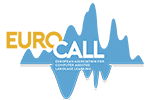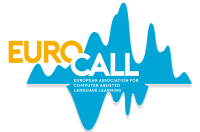Publicaciones
Desde principios del año 2000 la revista ReCALL pasa a ser publicada por la editorial británica Cambridge University Press. El primer volumen publicado por esta editorial fue el Volumen 12, Parte 1ª de Mayo de 2000 que reunía una selección de las ponencias presentadas al congreso anual celebrado en Besançon, Francia, en septiembre de 1999. A todos los socios de EUROCALL se les proporcionará una clave de usuario para acceder a la versión electrónica de dicha publicación a través de Cambridge Core:
https://www.cambridge.org/core/journals/recall
ISSN 0958-3440
Se puede acceder a todos los números atrasados de ReCALL a través de Cambridge Core.
Desde enero de 2021, ReCALL sólo se publica en formato electrónico.
CALL Software Design and Implementation: the template approach
Gimeno Sanz, Ana M. (2002) Valencia: Servicio de Publicaciones de la Universidad Politécnica de Valencia.
Reseña
Gimeno, A.. (2002) CALL Software Design and Implementation: The Template Approach, Valencia: Servicio de Publicaciones Universidad Politécnica de Valencia, 141 page book, ISBN 84-9705-099-1. Available from agimeno@idm.upv.es
This book was published in 2002 by the Polytechnic University of Valencia, the institution where the author is based and where she has been involved in various pioneering international projects developing CALL software for the acquisition of foreignl languages for the past ten years. It is a book, therefore, which showcases the author’s expertise from a practical point of view. The R&D group which she leads has produced quality interactive CALL programs successfully over the years by following the template approach to authoring, and whose rationale and design issues are discussed throughout this book. As a matter of fact, it is the work of a language professor and researcher, a CALL practitioner who reflects on instructional design for language learning out of experience, rather than from a merely theoretical point of view.
The book is concise and focusses on real examples of good CALL practice. It is divided into six chapters, an appendix containing examples of real questionnaires for needs analysis, and a bibliography of both printed and electronic references. The overall structure proceeds from a general, more theoretical view and rationale to the contextualised presentation of actual template examples. The opening chapter is an introduction to the CALL programs developed by the author in co-operation with several other researchers and institutions, and serves to put the later examples of practice within a context. It is full of references to CALL projects which the interested reader may seek out. The second chapter, entitled First Considerations, discusses some of the issues and questions to be considered before starting the CALL project development process, such as the target group, needs analysis, the pedagogical approach and the sound use of educational technology, the latter being at the heart of the whole book. The following chapter, Personnel and Tools, argues that qualified people and suitable support software must interact in a co-ordinated way in order to develop a coherent and successful CALL application. Chapter 4 discusses some of the most important instructional design features to ensure user-friendliness from a pedagogical point of view. Key design issues concerning feedback, exercise interface, reference and help materials, and so forth, are explored and considered as elements of prime importance to ensure that the final product is easy to use and supportive of learner-centredness. The following chapter is a brief but wonderfully concise and clear account of the major components of the template approach to CALL software design and development. It even includes a rationale for its use which could not be expressed in fewer words or more clearly. The author explains why she adopts this approach rather than other authoring options at hand and certainly does so in a very convincing way.
The central part of the book is contained within Chapter 6, Template Examples, where the reader finds actual examples of template implementation for the main activities found in CALL courseware. Although at first sight this section seems rather repetitive, a closer look at the content justifies the inclusion of so many template examples corresponding to different exercise types. This chapter is more closely addressed to technical staff (programmers and the like) than the rest of the book, or at least to those who are more familiar with CALL authoring and development. Thus, the template approach is not discussed around a purely theoretical framework for CALL, but conceptualised as a practical method which is useful for teachers, researchers and software programmers alike. And the examples given show that the template approach allows for the creation of variety even within very similar exercises. This is actually one of the main advantages of CALL programs, i.e. to cater for different delivery formats adaptable to different situations and study styles with little technical modifications at the authoring level, thus promoting learner autonomy. The way in which this can be technically achieved is demonstrated in the book, in general, and in chapter 6 in particular.
Chapter 7 is an appendix presenting examples of questionnaires used prior to developing the main features of CALL multimedia courses, that is to say, at the needs analysis stage. The author herself is professionally involved with the teaching of Languages for Specific Purposes, a field where needs analysis plays an important role in course design. This probably explains, if any explanation is needed, Dr. Gimeno’s interest in this preparation phase. Anyone who wishes to further explore the actual CALL programs which were developed by applying this approach can follow up the references to them at the end of the book, together with a bibliography of theoretical and practical CALL texts. Though brief, this reference section is sufficient for the purposes of the book.
The template approach to CALL software design and development is one in which people with diverse interests and backgrounds, i.e. technical programmers, language specialists (often a teacher) and graphics designers, work partly in an independent way and partly in close co-ordination, keeping the building blocks and features of the course separate until they are finally assembled in a coherent whole aiming at improving the learning of languages through technology. The book develops this idea in a beautifully concise way. Some readers might have preferred more discussion, on the other hand the book sets out to take no more of our time than necessary to explain the niceties of this authoring approach. This work, unlike many of its sort, addresses the technical developer as well as the CALL practitioner or researcher, and there is indeed a need for this kind of publication if both groups are to work together in the CALL software development process. The book reads smoothly and, although there could perhaps be more bibliographical references, it bridges a gap in the CALL literature between CALL teachers and their partners, the software programmers.
Review by Rafael Seiz Ortiz
Universidad Politécnica de Valencia, Spain
CALL Courseware Development: A Handbook
Editado por Françoise Blin, Nicole Chenik y June Thompson
Versión electrónica en formato de archivo .pdf. El lector de archivos .pdf (Adobe Acrobat Reader) se puede descargar accediendo al servidor de Adobe en http://www.adobe.com.
Este manual recopila información sobre proyectos de investigación y desarrollo que se están llevando a cabo en el ámbito de CALL. Dicha recopilación se realizó a través del EUROCALL Directory of Courseware Development Projects, base de datos que reune las experiencias de diversos expertos en el desarrollo de cursos y materiales didácticos para la enseñanza de lenguas asistida por ordenador. La creación de la base de datos fue subvencionada por la Comisión de las Comunidades Europeas (DGXXII Educación, Formación y Juventud). Tras una introducción, cada uno de los temas tratados aparecen en forma de “pregunta-respuesta” centrándose en aspectos concretos relacionados con el desarollo de materiales didácticos para CALL.
En el manual se incluyen capítulos que se centran en:
- Design Methodologies
- Evaluation and Testing
- Implementation and Integration
- Project Management
- Commercialisation
y contiene, además, una lista bibliográfica de lecturas recomendadas.
ISBN: 0 9520183 7 3
Language Processing in CALL
Editado por Mathias Schulze, Marie-Josée Hamel y June Thompson
Edición especial de la publcación ReCALL que recoge artículos a partir del seminario “Natural Language Processing in Computer-Assisted Language Learning” celebrado en la Universidad de Manchester – Institute for Science and Technology (Reino Unido), el 9 de mayo de 1998, y organizado por el Centre for Computational Linguistics en colaboración con EUROCALL.
ISBN: 0 9520183 57
Edición especial electrónica de ReCALL
Publicación electrónica de una edición especial de ReCALL editada por William Howarth, coordinador del Proyecto WELL (Web Enhanced Language Learning). Este proyecto, subvencionado por la Dirección General de Enseñanza Superior Británica -Fund for the Development of Teaching and Learning-, estudia e investiga sistemas y metodologías de enseñanza asistidas por la WWW y está abierto a la participación de profesores de idiomas de todo el mundo. Se puede acceder a este monográfico a través de Ediciones electrónicas.
La Asociación publica una revista electrónica bianual bajo el título, The EuroCALL Review, editada por Ana M. Gimeno Sanz. La publicación es de acceso abierto e incluye información sobre proyectos de investigación, desarrollo e innovación relacionados con la enseñanza de lenguas asistida por ordenador, artículos de opinión, reseñas bibliográficas y de webs para la enseñanza/aprendizaje de lenguas extranjeras, etc. La publicación cuenta con un consejo editorial y un comité científico que vela por la calidad de los contenidos y revisa los artículos científicos que en ella se publican siguiendo el modelo “doble ciego”.
The EuroCALL Recview está alojada en el portal de revistas electrónicas de la Universitat Politècnica de València: https://polipapers.upv.es/index.php/eurocall
Para contribuir a esta revista, acceda a ese enlace.
ISSN: 1695-2618
Los pedidos de libros se han de realizar, mediante petición oficial, a la Oficina Central de EUROCALL en la Universidad de Ulster (Coleraine, Irlanda del Norte).
Los pagos se pueden efectuar mediante tarjeta de crédito (excepto American Express/Diners) o mediante cheque bancario pagadero a EUROCALL. No se podrán emitir facturas por un valor menor a 35 euros.
Especifique su número de afiliación a EUROCALL para beneficiarse de los descuentos.
Envíe su pedido a la siguiente dirección:
EUROCALL
School of Languages, Literatures and Cultures
University of Ulster
Coleraine
Northern Ireland, BT52 1SAEmail: eurocall@ulster.ac.uk
Tel: +44 (0)287 032 3992


